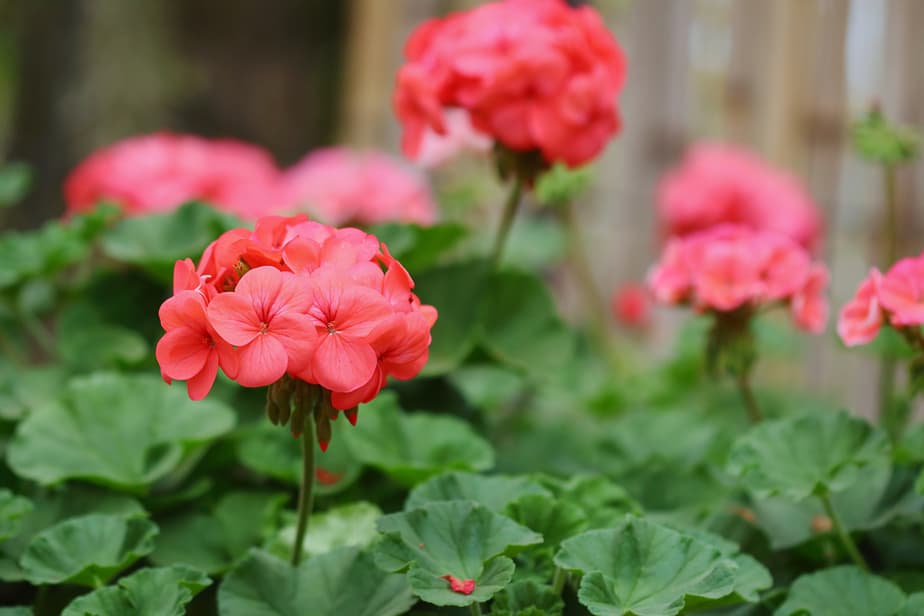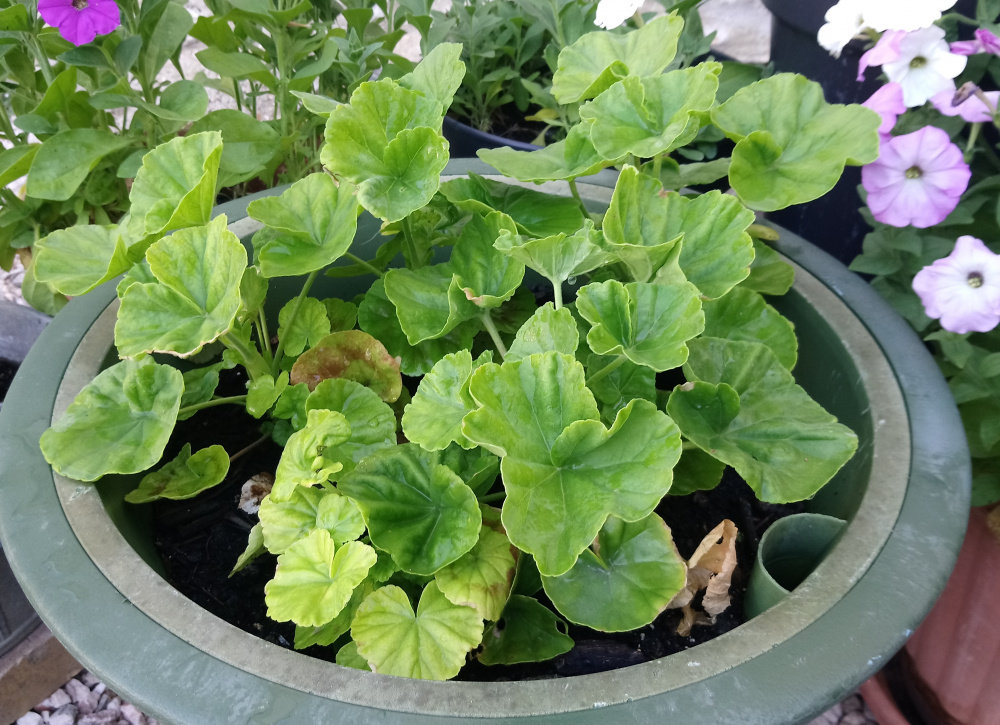With the majority of their species being native to South Africa, geraniums (also known as pelargoniums or storksbills) are drought and heat tolerant plants that, under the appropriate circumstances, may bloom all year round in warm regions.
Geraniums don’t bloom because of wet soil, excessive shade, chilly temperatures, and high nitrogen fertilizer. To blossom in the summer, geraniums need well-draining soil, potassium fertilizer, full light, and nights that are regularly warmer than 55°F (12°C).
To find out why your geraniums aren’t flowering and how to put the best practices into practice so that they bloom to their full potential, keep reading.
Table of Contents
Over Watering or Slow Draining Soils Prevents Geraniums Blooming
80 percent of the 250 species of geraniums, also known as pelargoniums, are indigenous to South Africa, where they bloom virtually all year in soil that tends to dry out a little in the summer months and in between periods of infrequent rainfall.
It’s crucial for plant health and flowering to replicate the soil moisture and watering regime of their natural habitat.
Therefore, two common reasons for germanium not blossoming are because of:
- excessive irrigation that keeps the soil damp or moist.
- Because of low-lying, bog-like places, or because of slow-draining soils like clay.
The capacity for flowering in the germanium might be hampered by fungal infections such root rot, which impairs efficient root respiration. Damp, bog soils can also stress the geranium.
Reduce your watering frequency if your geraniums aren’t blooming so that the soil has a chance to somewhat dry out in between applications of water.
If there hasn’t been much rain this summer, you should typically water geraniums in pots and containers once a week. Only water geraniums planted along garden borders when there is a drought.
The most essential thing is to tailor the frequency of watering to your particular temperature and weather conditions (so that the soil has a chance to dry out).
Test the soil with your finger to see if your geraniums need watering; if they do, wait a few days before watering again, but if the soil feels dry to the touch, give them a good soak.
Plant geraniums in pots, containers, or hanging baskets to mimic the ideal dryer soil conditions, which boosts the geraniums’ likelihood of blossoming, if your garden soil is wet, poor draining due to clay or compacted soil.
If the soil is continuously moist, move any geraniums as soon as possible to a location with full sun and soil that drains well to improve the likelihood of a strong flower display.
Always give geraniums a good soak when you water them because this helps the roots expand and take root in the soil, which boosts the plant’s tolerance to drought.
Potted Geraniums Not Flowering
Geraniums grow and flower exuberantly in pots due to the favourable drainage conditions, however it is vital that your pot or container has drainage holes at the base for excess water to escape.
Without proper drainage, soil becomes soggy in pots and containers, where the plant either dies from root rot or becomes water-stressed and does not blossom.
This is especially true for indoor germanium plants because gardeners sometimes cover the bottom of the pot with a saucer or decorative outer pot to prevent water from leaking out and onto your furniture. Always make sure water can drain out of the pot so that the soil does not become water-logged.
I advise using a pot around 12 inches across for outdoor-potted geraniums so that there is enough room for soil and nutrients for the plant to flower.
A larger pot has the ability to retain moisture in hotter regions so that food won’t dry out too rapidly.
For potted geraniums to flower, fertilizer applications become more crucial since the roots may deplete the nutrients in the container, which decreases flowering.
Not Enough Sun for Geranium Flowering
Put your geraniums in a spot with around 6 hours of sun each day for more robust blooms.
Geraniums that receive too much shade become leggy and produce significantly fewer blooms.
For most climates and most germanium cultivars, morning sun followed by afternoon shade is ideal for flowering and a healthy plant.
Geraniums bloom best in full sun in cooler climates like the Pacific North West or the UK. Germanium prefers the morning sun followed by shade since it can benefit from some protection from the scorching noon sun in hotter locations like Southern California or the Mediterranean.
If your geraniums aren’t blooming, move them to full sun if they’re outdoors and to a sunny window if they’re indoors so they have the energy they need.
Too Much Fertilizer Prevents Geraniums to Flowering
Geraniums are not necessarily heavy feeders so fertilizing too frequently or with too high concentration can promote foliage growth at the expense of flowers.
This is especially true for fertilizers heavy in nitrogen.
Scale back the use of fertilizer to; at the most once every 2 weeks with a well balanced general soluble liquid fertilizer ensuring the the ratio of Nitrogen, Phosphorous and potassium is even (10:10:10 NPK) (10:10:10 NPK).
With a fertilizer that has a higher potassium content, geraniums produce more flowers once flower buds start to appear (as potassium encourages flowering).
You can use a particular product for geraniums that is available from amazon and garden centers that is higher in potassium to stimulate flowering, or you can feed tomato plants, which are wonderful for increasing germanium blossoms.
Cool Temperatures Prevents Flowering
Geraniums only bloom in temperate locations when the nighttime temperature regularly stays over 55° F, or 12° Celsius, and can flower all year long in ideal conditions, such as those in their original environment of South Africa.
Therefore the reason your geraniums are not flowering may be be because it is too early in the season and they are waiting for warmer temperatures.
Geraniums can flower all summer long once the weather is consistently warm, up until the temperatures start to drop in the fall.
It is important to keep in mind that geraniums are sensitive to substantial temperature changes, so moving a potted plant from a warm house to a relatively much cooler garden can induce shock and impede flowering.
Move geraniums outside for a few hours each day for about two weeks. Gradually increase their time outside to acclimate them to the temperature difference, and the geranium will be less likely to experience shock and more likely to flower.
Remember that geraniums often cannot tolerate frost and should be brought indoors if they are potted or treated as an annual flowering plant in gardens located in colder climes.
Soil Conditions Required for Geraniums to Bloom
- Light, friable soil is necessary for geraniums in order to promote root respiration and proper drainage (geraniums do not tolerate damp soil). Before planting, amend the planting area with multipurpose compost and stay away from garden regions that are inherently wet or muddy.
- Geraniums should be planted in pots, containers, or hanging baskets rather than in heavy clay soils, compacted soil, or any slow-draining soil.
- The application of fertilizer is more necessary for geraniums to flower in soil that is more sandy or deficient in nutrients. Geraniums can be fertilized with a standard all-purpose fertilizer, but once blooms start to appear, a high potassium fertilizer (like tomato feed) encourages additional blooming throughout the summer.
Geraniums are more likely to produce a good number of flowers when grown in light, well-draining soil that has been amended with plenty of compost (and fertilizer).
Key Takeaways:
- If the soil is consistently moist, there is too much shade, there is too much nitrogen fertilizer, it is too cold outside, or the plant is in a small pot with insufficient nutrients, geraniums won’t bloom.
- For geraniums to bloom, they need well-draining soil, full light, potassium fertilizer, and regular nighttime temperatures over 55°F (12°C).
- South African-bred geraniums prefer their soil to be relatively dry in between waterings in order to flourish and bloom.
FAQ
How do you get geraniums to bloom?
Give geraniums plenty of sunlight to encourage flowering; 4 to 6 hours of direct sunlight each day will work wonders! Give your potted plants exposure to the south and west for profusion of blossoms.
Is Miracle Grow good for geraniums?
When growing geraniums in planting beds, mix 3 inches of Miracle-Gro® Garden Soil for Flowers into the top 6 to 8 inches of native soil to improve soil drainage and quality. When growing geraniums in pots, Miracle-Gro® Potting Mix in a light, fluffy consistency is excellent.
How do you know if your geraniums are overwatered?
Geraniums typically have yellow leaves at the bottom when they are overwatered. They could also get water patches that appear pale. If so, you should cease watering right away so that the plants can dry off. Remember that geraniums do not like excessive amounts of water and are drought-tolerant plants.
What can I feed my geraniums to make them flower?
Use a time-release fertilizer to feed your geranium once in the spring, or use an all-purpose granular fertilizer in the spring and summer. If the potting soil has fertilizer included, you won’t need to feed your plant at all for the first several weeks.



